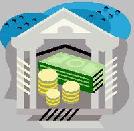
 |
|
| Financial Terms | |
| Crown jewel |
|
Information about financial, finance, business, accounting, payroll, inventory, investment, money, inventory control, stock trading, financial advisor, tax advisor, credit.
Main Page: finance, tax advisor, credit, payroll, financial advisor, investment, inventory control, business, |
Definition of Crown jewel
Crown jewelA particularly profitable or otherwise particularly valuable corporate unit or asset of a firm.
Related Terms:Acquisition of assetsA merger or consolidation in which an acquirer purchases the selling firm's assets. Affirmative covenantA bond covenant that specifies certain actions the firm must take. Asian currency units (ACUs)Dollar deposits held in Singapore or other Asian centers. AssetAny possession that has value in an exchange. Asset/equity ratioThe ratio of total assets to stockholder equity. Asset/liability managementAlso called surplus management, the task of managing funds of a financial Asset activity ratiosRatios that measure how effectively the firm is managing its assets.  Asset allocation decisionThe decision regarding how an institution's funds should be distributed among the Asset-backed securityA security that is collateralized by loans, leases, receivables, or installment contracts Asset-based financingMethods of financing in which lenders and equity investors look principally to the Asset classesCategories of assets, such as stocks, bonds, real estate and foreign securities. Asset-coverage testA bond indenture restriction that permits additional borrowing on if the ratio of assets to Asset for asset swapCreditors exchange the debt of one defaulting borrower for the debt of another Asset pricing modelA model for determining the required rate of return on an asset. Asset substitutionA firm's investing in assets that are riskier than those that the debtholders expected. Asset substitution problemArises when the stockholders substitute riskier assets for the firm's existing  Asset swapAn interest rate swap used to alter the cash flow characteristics of an institution's assets so as to Asset turnoverThe ratio of net sales to total assets. Asset pricing modelA model, such as the Capital asset Pricing Model (CAPM), that determines the required AssetsA firm's productive resources. Assets requirementsA common element of a financial plan that describes projected capital spending and the Capital asset pricing model (CAPM)An economic theory that describes the relationship between risk and Confirmationhe written statement that follows any "trade" in the securities markets. Confirmation is issued Corporate acquisitionThe acquisition of one firm by anther firm. Corporate bondsDebt obligations issued by corporations. Corporate charterA legal document creating a corporation. Corporate financeOne of the three areas of the discipline of finance. It deals with the operation of the firm  Corporate financial managementThe application of financial principals within a corporation to create and Corporate financial planningFinancial planning conducted by a firm that encompasses preparation of both Corporate processing floatThe time that elapses between receipt of payment from a customer and the Corporate tax viewThe argument that double (corporate and individual) taxation of equity returns makes Corporate taxable equivalentRate of return required on a par bond to produce the same after-tax yield to Current assetsValue of cash, accounts receivable, inventories, marketable securities and other assets that Doctrine of sovereign immunityDoctrine that says a nation may not be tried in the courts of another country Dynamic asset allocationAn asset allocation strategy in which the asset mix is mechanistically shifted in European Currency Unit (ECU)An index of foreign exchange consisting of about 10 European currencies, Exchange of assetsAcquisition of another company by purchase of its assets in exchange for cash or stock. Financial assetsClaims on real assets. FirmRefers to an order to buy or sell that can be executed without confirmation for some fixed period. Also, Firm commitment underwritingAn undewriting in which an investment banking firm commits to buy the Firm's net value of debtTotal firm value minus total firm debt. Firm-specific riskSee:diversifiable risk or unsystematic risk. Fixed assetLong-lived property owned by a firm that is used by a firm in the production of its income. Fixed asset turnover ratioThe ratio of sales to fixed assets. Future investment opportunitiesThe options to identify additional, more valuable investment opportunities Growth opportunityOpportunity to invest in profitable projects. Intangible assetA legal claim to some future benefit, typically a claim to future cash. Goodwill, intellectual Intrinsic value of a firmThe present value of a firm's expected future net cash flows discounted by the Liquid assetasset that is easily and cheaply turned into cash - notably cash itself and short-term securities. Long-term assetsValue of property, equipment and other capital assets minus the depreciation. This is an Limitation on asset dispositionsA bond covenant that restricts in some way a firm's ability to sell major assets. Neglected firm effectThe tendency of firms that are neglected by security analysts to outperform firms that Net asset value (NAV)The value of a fund's investments. For a mutual fund, the net asset value per share Net assetsThe difference between total assets on the one hand and current liabilities and noncapitalized longterm Net present value of growth opportunitiesA model valuing a firm in which net present value of new Non-reproducible assetsA tangible asset with unique physical properties, like a parcel of land, a mine, or a Opportunity cost of capitalExpected return that is foregone by investing in a project rather than in Opportunity costsThe difference in the performance of an actual investment and a desired investment Opportunity setThe possible expected return and standard deviation pairs of all portfolios that can be Other current assetsValue of non-cash assets, including prepaid expenses and accounts receivable, due Policy asset allocationA long-term asset allocation method, in which the investor seeks to assess an Portfolio opportunity setThe expected return/standard deviation pairs of all portfolios that can be Present value of growth opportunities (NPV)Net present value of investments the firm is expected to make Publicly traded assetsassets that can be traded in a public market, such as the stock market. Quick assetsCurrent assets minus inventories. Real assetsIdentifiable assets, such as buildings, equipment, patents, and trademarks, as distinguished from a Reproducible assetsA tangible asset with physical properties that can be reproduced, such as a building or Residual assetsassets that remain after sufficient assets are dedicated to meet all senior debtholder's claims in full. Return on assets (ROA)Indicator of profitability. Determined by dividing net income for the past 12 months Return on total assetsThe ratio of earnings available to common stockholders to total assets. Riskless or risk-free assetAn asset whose future return is known today with certainty. The risk free asset is Risky assetAn asset whose future return is uncertain. Risk-free assetAn asset whose future return is known today with certainty. Small-firm effectThe tendency of small firms (in terms of total market capitalization) to outperform the Tactical Asset Allocation (TAA)An asset allocation strategy that allows active departures from the normal Tangible assetAn asset whose value depends on particular physical properties. These i nclude reproducible Target firmA firm that is the object of a takeover by another firm. Total asset turnoverThe ratio of net sales to total assets. Underlying assetThe asset that an option gives the option holder the right to buy or to sell. Unit benefit formulaMethod used to determine a participant's benefits in a defined benefit plan by Unit investment trustMoney invested in a portfolio whose composition is fixed for the life of the fund. Wasting assetAn asset which has a limited life and thus, decreases in value (depreciates) over time. Also ASSETSAnything of value that a company owns. Current assetsCash, things that will be converted into cash within a year (such as accounts receivable), and inventory. RATE OF RETURN ON TOTAL ASSETSThe percentage return or profit that management made on each dollar of assets. The formula is: UNITS OF PRODUCTIONA depreciation method that relates a machine’s depreciation to the number of units it makes each AssetsThings that the business owns. Current assetsAmounts receivable by the business within a period of 12 months, including bank, debtors, inventory and prepayments. Fixed assetsThings that the business owns and are part of the business infrastructure – fixed assets may be Intangible fixed assetsNon-physical assets, e.g. customer goodwill or intellectual property (patents and trademarks). Opportunity costThe lost opportunity of not doing something, which may be financial or non-financial, e.g. time. Tangible fixed assetsPhysical assets that can be seen and touched, e.g. buildings, machinery, vehicles, computers etc. AssetsItems owned by the company or expenses that have been paid for but have not been used up. Contra-asset accountAn offset to an asset account that reduces the balance of the asset account. Intangible assetsassets owned by the company that do not possess physical substance; they usually take the form of rights and privileges such as patents, copyrights, and franchises. asset turnover ratioA broad-gauge ratio computed by dividing annual current assetsCurrent refers to cash and those assets that will be turned fixed assetsAn informal term that refers to the variety of long-term operating return on assets (ROA)Although there is no single uniform practice for Related to : financial, finance, business, accounting, payroll, inventory, investment, money, inventory control, stock trading, financial advisor, tax advisor, credit. |